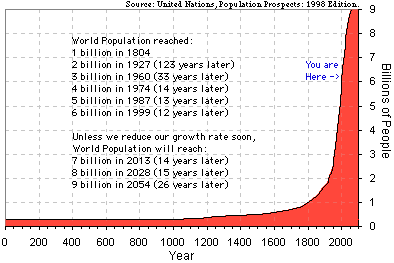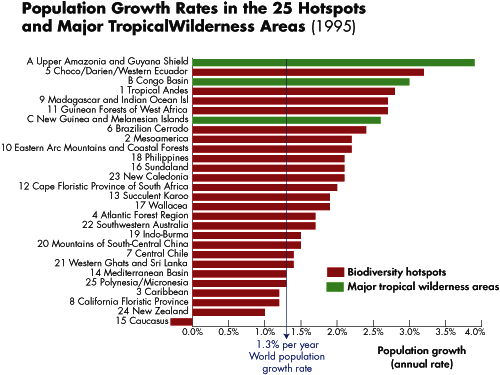
There are hundreds of ways that population can be linked to environmental problems. Ever since the first humans, the population of the earth has been growing. It has been an exponential increase, starting rather slowly, and, in the last few years, shooting upwards at terrifying rates:

Chart courtesy of: http://www.learner.org/jnorth/images/graphics/n-r/popu_GrowthChartWPB.gif
There is no way to calculate the carrying capacity of the Earth, as it is a figure entirely dependent on what one considers a basic standard of living conditions. However, I think everyone can agree that eventually, if population rose high enough, the earth will not be able to sustain all of its inhabitants. Perhaps we have reached this point already. Millions of people on the planet are starving, in both undeveloped and developed countries. Unfortunately, it is also in those countries that the population is growing at the fastest rates (see chart below). But they are not the only ones being blamed for the excess of people on the planet. Religious people, namely Jews and Christians, are among the scapegoats, as the Old Testament reads “be fruitful and multiply”.

Chart courtesy of Population, Health and Environment (PHE) http://www.ehproject.org/phe/phe.html.
In 1968, population biologist Paul Ehrlich wrote a book entitled “The Population Bomb”. It predicted that by 1977, food supplies would run out and there would be mass famines. The population would begin to plummet as millions died of starvation, diseases would run rampant as human immune systems would become too weak to fight them off. Thousands of people read these warnings, and yet, nothing was done. People in developed countries continued living extravagantly, people in undeveloped countries continued to live in poverty and half-starvation, having children as fast as they could (and watching a high percentage of those children die in infancy). Nothing really changed. Today, we are finally starting to pay attention to population and its negative effects on the planet.
In countries like India, food shortage is a constant issue. In 1963, when India’s food supplies were at devastatingly low levels – the brink of massive famines – they were saved by wheat developed by Norman Borlaug, who brought three strains of hybridized, genetically selected wheat from Mexico to India, where they were wildly successful; India was saved (The Economist, 2005).
Today, we attempt to feed the masses using industrial agriculture. We have factory farms for meat production. Our genetically modified crops grow in pesticide-laden, nutrient-exhausted soil. We sacrifice almost all that is natural about meat and vegetable in the name of quantity (Pollan, 2006). Unfortunately, it isn’t solving out problems. Industrialized farming merely allows those of us who can afford to buy food to eat as much meat as possible (meat with almost none of the nutritional value of meat), and have the vegetables we want year-round (vegetables that cannot absorb any nutrients from the soil as there are none to be absorbed). In a sense, while we are perhaps putting food in the mouths of a larger number of people, we are half-starving everyone of the nutrients they need to be healthy.
The steps we have been taking to feed the massive population of the Earth are coming at a huge price. Genetically modified plants are replacing natural flora rapidly, decreasing biodiversity. Soils are being exhausted by over planting. Animals are being grown in the worst possible conditions, treated horribly, and are not fed to create healthy meat. The methane that comes from the massive amounts of waste from these animals is compromising the health of the planet. The food that is produced is unhealthy and non-nutritious, only furthering starvation. We are setting ourselves up for disaster by continuing these practices. Our attempts to feed all of the people are killing the planet on which we live.
Sources:
"Ears of Plenty". The Economist. December 24, 2005.
Ehrlich, Paul. The Population Bomb. Sierra Club-Ballantine Books. 1968.
Pollan, Michael. The Omnivore's Dilemma: A Natural History of Four Meals. Penguin Books. 2006.
"Population, Heath and Environment". Environmental Health. http://www.ehproject.org/phe/phe.html
Send message to Swarthmore College Environmental Studies
last updated 4/30/08
webmaster